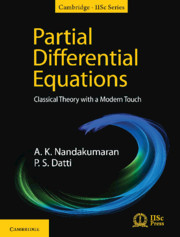Book contents
- Frontmatter
- Dedication
- Contents
- List of Illustrations
- Preface
- Acknowledgments
- Notations
- Chapter 1 Introduction
- Chapter 2 Preliminaries
- Chapter 3 First-Order Partial Differential Equations: Method of Characteristics
- Chapter 4 Hamilton–Jacobi Equation
- Chapter 5 Conservation Laws
- Chapter 6 Classification of Second-Order Equations
- Chapter 7 Laplace and Poisson Equations
- Chapter 8 Heat Equation
- Chapter 9 One-Dimensional Wave Equation
- Chapter 10 Wave Equation in Higher Dimensions
- Chapter 11 Cauchy–Kovalevsky Theorem and Its Generalization
- Chapter 12 A Peep into Weak Derivatives, Sobolev Spaces and Weak Formulation
- References
- Index
Chapter 1 - Introduction
Published online by Cambridge University Press: 20 May 2020
- Frontmatter
- Dedication
- Contents
- List of Illustrations
- Preface
- Acknowledgments
- Notations
- Chapter 1 Introduction
- Chapter 2 Preliminaries
- Chapter 3 First-Order Partial Differential Equations: Method of Characteristics
- Chapter 4 Hamilton–Jacobi Equation
- Chapter 5 Conservation Laws
- Chapter 6 Classification of Second-Order Equations
- Chapter 7 Laplace and Poisson Equations
- Chapter 8 Heat Equation
- Chapter 9 One-Dimensional Wave Equation
- Chapter 10 Wave Equation in Higher Dimensions
- Chapter 11 Cauchy–Kovalevsky Theorem and Its Generalization
- Chapter 12 A Peep into Weak Derivatives, Sobolev Spaces and Weak Formulation
- References
- Index
Summary
GENERAL NATURE OF PDE
It is no exaggeration to state that partial differential equations (PDE) haveplayed a vital role in the development of science and technology, primarilysince the beginning of the twentieth century. In the earlier stage, PDE weremainly used to describe physical phenomena, like vibrations of strings, heatconduction in solids, transport phenomena, to mention a few. Later, with theadvantage of mathematical modelling, the scope of using PDE for thedescription of phenomena occurring in biology, economics and even sociologybecame prominent.
Since the days of Newton or even earlier, many have attempted to describephysical processes using mathematics. Such a mathematical description oftenleads to linear differential, integral and even integro-differentialequations. Thus, a large number of PDE naturally come from mathematicalphysics. The initial developments in PDE, though, were mainly geared towardsobtaining solutions to a particular physical or engineering problem, it wassoon realized that many of the problems will have common features andsimilarities. This naturally led to the grouping of PDE that can be tackledin a single framework. This automatically leads to the abstraction of thesubject and the theoretical analysis that follows, hence, becomes moreimportant. This is one of the features we try to follow in the present book.Indeed, unlike ordinary differential equations (ODE), all PDE including thelinear ones cannot be treated in a single theoretical framework, leading tothe necessity of a classification. In fact, due to the diverse nature ofphysical phenomena, we remark that we cannot classify all the PDE.Nevertheless, a fairly good classification is available for the second-orderequations and interestingly a large number of physical and other problemslead to second-order equations. Also, for the three important classes ofequations, namely elliptic, hyperbolic and parabolic, general theories havebeen developed.
As mentioned above, a wide class of physical problems is described bysecond-order linear differential equations of the form Here the variablex varies in an open set in the physical spaceℝn; n = 1;2; 3 and the coefficients aij;bi and c are known from thephysical process; u is the unknown function andf denotes an external quantity, if any, influencing thephysical process.
- Type
- Chapter
- Information
- Partial Differential EquationsClassical Theory with a Modern Touch, pp. 1 - 6Publisher: Cambridge University PressPrint publication year: 2020



